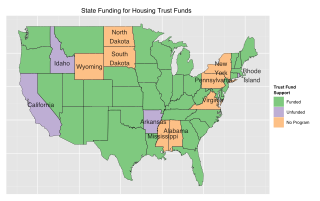The Low-Income Housing Tax Credit (LIHTC) is a federal program in the United States that awards tax credits to housing developers in exchange for agreeing to reserve a certain fraction of rent-restricted units for lower-income households. The program was created under the Tax Reform Act of 1986 (TRA86) to incentivize the use of private equity in developing affordable housing. Projects developed with LIHTC credits must maintain a certain percentage of affordable units for a set period of time, typically 30 years, though there is a "qualified contract" process that can allow property owners to opt out after 15 years. The maximum rent that can be charged for designated affordable units is based on Area Median Income (AMI); over 50% of residents in LIHTC properties are considered Extremely Low-Income. Less than 10% of current credit expenditures are claimed by individual investors.

Canada Mortgage and Housing Corporation is Canada's federal crown corporation responsible for administering the National Housing Act, with the mandate to improve housing by living conditions in the country.

Affordable housing is housing which is deemed affordable to those with a household income at or below the median as rated by the national government or a local government by a recognized housing affordability index. Most of the literature on affordable housing refers to mortgages and a number of forms that exist along a continuum – from emergency homeless shelters, to transitional housing, to non-market rental, to formal and informal rental, indigenous housing, and ending with affordable home ownership.

The Mitchell–Lama Housing Program is a non-subsidy governmental housing guarantee in the state of New York. It was sponsored by New York State Senator MacNeil Mitchell and Assemblyman Alfred A. Lama. It was signed into law in 1955 as The Limited-Profit Housing Companies Act.
The HOME Investment Partnerships Program (HOME) is a type of United States federal assistance that the U.S. Department of Housing and Urban Development (HUD) provides to states to create decent and affordable housing, particularly housing for low and very low income Americans. It is the largest Federal block grant to states and local governments designed exclusively to create affordable housing for low-income families, providing approximately US$2 billion each year.
The New York State Housing Finance Agency (HFA) is a New York State public-benefit corporation created in 1960 to increase the supply of rental housing for low-income people by issuing bonds and providing low-interest mortgage loans to regulated housing companies.

The California Housing Finance Agency (CalHFA), established in 1975, is an independent California state agency within the California Department of Housing and Community Development that makes low-rate housing loans through the sale of taxable and tax exempt bonds.

In the United States, subsidized housing is administered by federal, state and local agencies to provide subsidized rental assistance for low-income households. Public housing is priced much below the market rate, allowing people to live in more convenient locations rather than move away from the city in search of lower rents. In most federally-funded rental assistance programs, the tenants' monthly rent is set at 30% of their household income. Now increasingly provided in a variety of settings and formats, originally public housing in the U.S. consisted primarily of one or more concentrated blocks of low-rise and/or high-rise apartment buildings. These complexes are operated by state and local housing authorities which are authorized and funded by the United States Department of Housing and Urban Development (HUD). In 2020, there were one million public housing units. In 2022, about 5.2 million American households received some form of federal rental assistance.
Public housing policies in Canada includes rent controls, as well as subsidized interest rates and grants. Early public housing policy in Canada consisted of public-private lending schemes which focused on expanding home ownership among the middle class. The first major housing initiative in Canada was the Dominion Housing Act of 1935, which increased the amount of credit available for mortgage loans.
The Pennsylvania Housing Finance Agency is a non-profit organization which serves the people of Pennsylvania by offering affordable housing resources, including loans and rent assistance. PHFA was created by an Executive Order by the Pennsylvania General Assembly in 1972.
Kentucky Housing Corporation (KHC), the Kentucky state housing agency, was created by the 1972 Kentucky General Assembly to provide affordable housing opportunities. KHC is a self-supporting, public corporation.

Housing trust funds are established sources of funding for affordable housing construction and other related purposes created by governments in the United States (U.S.). Housing Trust Funds (HTF) began as a way of funding affordable housing in the late 1970s. Since then, elected government officials from all levels of government in the U.S. have established housing trust funds to support the construction, acquisition, and preservation of affordable housing and related services to meet the housing needs of low-income households. Ideally, HTFs are funded through dedicated revenues like real estate transfer taxes or document recording fees to ensure a steady stream of funding rather than being dependent on regular budget processes. As of 2016, 400 state, local and county trust funds existed across the U.S.
Non-profit housing developers build affordable housing for individuals under-served by the private market. The non-profit housing sector is composed of community development corporations (CDC) and national and regional non-profit housing organizations whose mission is to provide for the needy, the elderly, working households, and others that the private housing market does not adequately serve. Of the total 4.6 million units in the social housing sector, non-profit developers have produced approximately 1.547 million units, or roughly one-third of the total stock. Since non-profit developers seldom have the financial resources or access to capital that for-profit entities do, they often use multiple layers of financing, usually from a variety of sources for both development and operation of these affordable housing units.

Affordable housing in Canada refers to living spaces that are deemed financially accessible to households with a median household income. Housing affordability is generally measured based on a shelter-cost-to-income ratio (STIR) of 30% by the Canada Mortgage and Housing Corporation (CMHC), the national housing agency of Canada. It encompasses a continuum ranging from market-based options like affordable rental housing and affordable home ownership, to non-market alternatives such as government-subsidized housing. Canada ranks among the lowest of the most developed countries for housing affordability.

Howard County Housing is the umbrella organization for the Howard County Department of Housing and Community Development and the Howard County Housing Commission. The Department is Howard County Government’s housing agency, and the Commission is a public housing authority and non-profit. Both have boards that meet monthly.
The Texas State Affordable Housing Corporation (TSAHC) is a nonprofit affordable housing provider in Texas.
The Utah Housing Corporation or UHC is a public corporation that the Utah legislature created in 1975 to advocate for affordable housing for lower-income residents in the state of Utah. UHC is an independent government agency that raises funds in order to offer mortgage loans to lower-income people and to provide resources to developers and builders for creating affordable housing projects. It does not receive any funds from the State of Utah and is completely self-supporting via the issuing of tax-exempt bonds and the creation of and selling of mortgage-backed securities to investors.

Affordable housing is housing that is deemed affordable to those with a median household income as rated by the national government or a local government by a recognized housing affordability index. A general rule is no more than 30% of gross monthly income should be spent on housing, to be considered affordable as the challenges of promoting affordable housing varies by location.
The New York State Division of Housing and Community Renewal (DHCR) is an agency of the New York state government responsible for administering housing and community development programs to promote affordable housing, community revitalization, and economic growth. Its primary functions include supervising rent regulations through the State Office of Rent Administration (ORA), administering affordable housing programs, providing financial assistance for housing development and rehabilitation, supporting community development initiatives, ensuring compliance with fair housing laws, and managing the Weatherization Assistance Program. DHCR has been criticized by tenant rights groups for its failure to monitor their own programs and massive delays in investigating cases of the illegal deregulation due to an extensive backlog.
The term "affordable housing" refers to housing that is considered economically accessible for individuals and families whose household income falls at or below the Area Median Income (AMI), as evaluated by either national or local government authorities through an officially recognized housing affordability index. However, in the US, the term is mostly used to refer to housing units that are deed restricted to households considered Low-Income, Very Low-Income, and Extremely Low-Income. These units are most often constructed by non-profit "affordable housing developers" who use a combination of private money and government subsidies. For-profit developers, when building market-rate developments, may include some "affordable" units, if required as part of a city's inclusionary zoning mandate.








